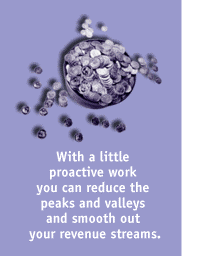
Managing Your Sales By Setting Priorities
| Продажи | ||||
| Sales.com | ||||
| Managing | ||||
by Gary Handelin
In these days of mergers and acquisitions, downsizing and right sizing everyone in sales has more activities to do than can be accomplished. If you don't spend your time on the correct sales activities you will not be able to maintain a steady sales flow, which leads directly to variable income where your compensation is based on performance to quota.
 You
peak at high sales levels when closing business. If you pursue closing
at the exclusion of prospecting and qualifying future business these peak
sales periods will be followed by troughs of minimal sales. In the extreme
case these troughs will be the lengths of your sales cycle. The resulting
classic roller coaster sales revenue chart results.
You
peak at high sales levels when closing business. If you pursue closing
at the exclusion of prospecting and qualifying future business these peak
sales periods will be followed by troughs of minimal sales. In the extreme
case these troughs will be the lengths of your sales cycle. The resulting
classic roller coaster sales revenue chart results.
With a little proactive work you can reduce the peaks and valleys and smooth out your revenue streams. The sales tool I use is the "Sales Funnel". In the most simplistic form, your sales funnel represents all opportunities you might pursue. It represents your rolling sales cycle with all the opportunities inserted in the appropriate place. The sales opportunities can be divided into four groups representing the sales activity you do: prospecting, qualifying, covering the bases and closing the order. Covering the bases means ensuring you have a plan to move the order to closure and that you are actively working the plan.
When you are prospecting you are pursuing potential customers who might have a need for your product or service. You try and identify where there might be a fit for your product or service. To move to qualifying you identify that there may be a fit between your product or service and the needs of your customer. Here you have identified a possible sales opportunity to pursue.
You move from qualifying to covering the bases by talking to at least one person who can influence the sales in a positive manner and identifying that a sales opportunity exists. At this point you can identify who you are selling to, what you are selling, how much you will sell it for and last, when you will sell it. These sales opportunities are now in your funnel. This is where the majority of your "selling" time is spent. You do all the things necessary in order to move the sales opportunity down to a close. Covering the bases will consist of identifying all the people that will be involved in the sales decision, what you know about the opportunity, what you don't know, and what you need to do to continue to move the sale forward.
Near the end of the sales cycle where there is very little left to do and the next steps are clearly defined, you move to closing the order. You have done virtually everything you can or need to do and the sale is coming down to a decision (for you or the competition). You have the greatest investment in the sale at this stage. You need to do everything necessary to position yourself for the sale. These are the opportunities you don't want to lose as they are going to happen soon (resulting in bookings and commission) and your cumulative investment is greatest.
Having defined the sales funnel, it's time to distinguish between priorities and time allocation. If you truly are going to "manage" your sales funnel your selling priorities must be fixed; your time allocation will vary based on what your sales funnel looks like. Let's consider priorities first.
Your first priority must be those opportunities in closing the order. These are the opportunities that represent your largest investment and most immediate return. Your next priority goes to prospecting, followed by qualifying and finally, covering the bases. The reason for this order is that this is the only way you manage your funnel. If you close an order, you must prospect and qualify to bring more than one new opportunity into your funnel. This provides for a steady flow of business. Failure to prospect and qualify will cause your funnel to dry up, with the associated loss of sales and commission revenue.
Moving from closing the order to prospecting, then qualifying and finally covering the bases allows you are continually bring new opportunities into your funnel. This allows you to smooth the peaks and troughs of your revenue stream. By maintaining this sales priority you manage sales opportunities so you always have these sales opportunities spread throughout your sales cycle. This provides you the best opportunity to smooth out your revenues. In a future article we will address time allocation as it relates to your fixed sales priorities.
Gary Handelin is a sales consultant for Miller Heiman, Inc. a Reno, Nevada-based Corporation that helps businesses develop sales processes. Gary has been working with organizations to install sales processes and improve sales operations and performance since 1988. You can reach Gary at Miller Heiman by calling (800) 526-6400 or visit our micro site for more information about Miller Heiman's products and services.